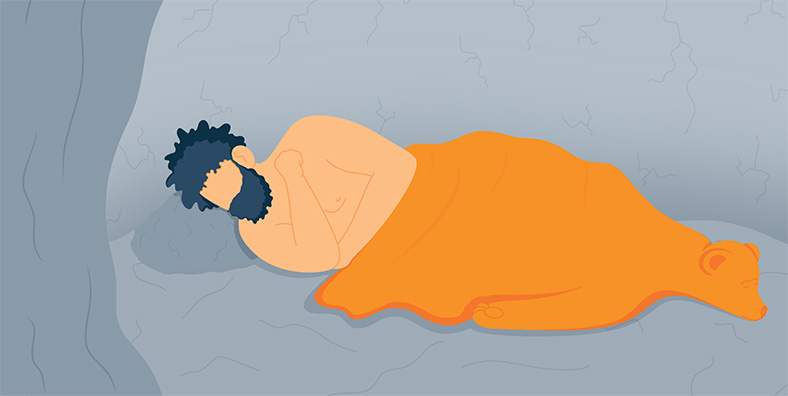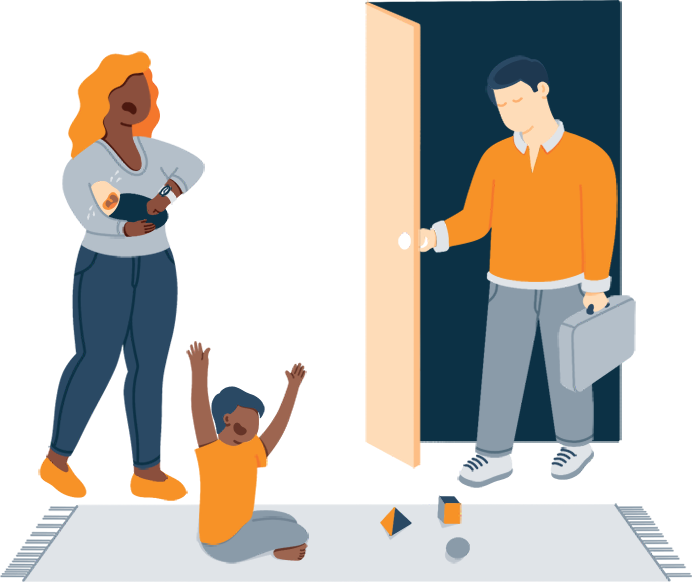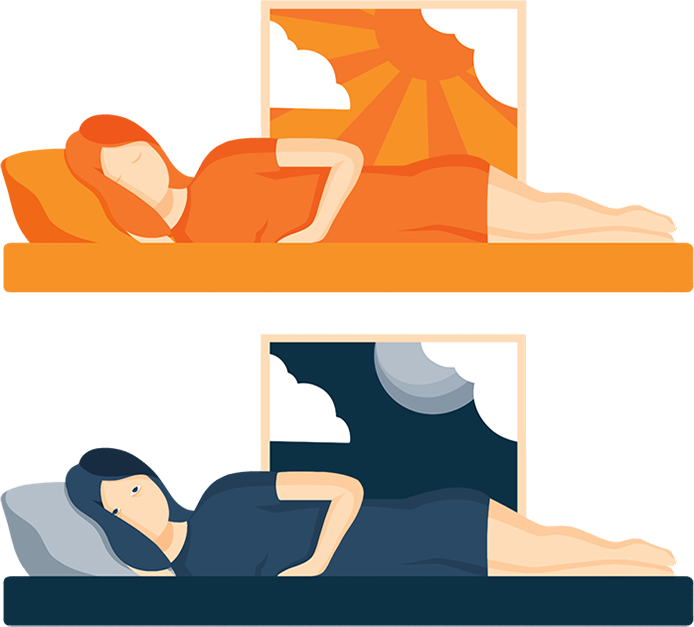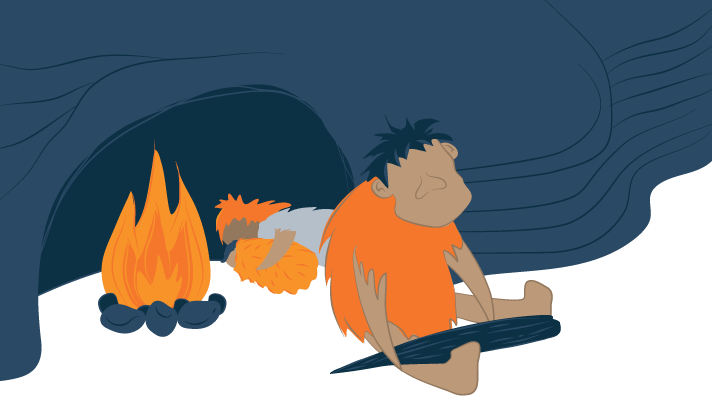Old Sleep Routine Where You Wake Up to Sleep Again Later
Ane out of every three people reports struggling with insomnia.
For some, they're unable to fall asleep, while others experience sleep maintenance insomnia, which means they can't maintain a state of sleep.
Nonetheless, these wakeful periods in the heart of the dark might not be then abnormal. In looking at the history of homo sleep, documented evidence shows that people would purposely split up their rest into periods. This practice is in sleep science known as biphasic or segmented slumber.
In this article, we'll take a look at slumber history, including biphasic rest and how it may exist helpful in the mod world, full of various sleep disorders.
When Was Sleeping Invented?
For as long as humans have roamed the Earth, we've needed slumber. As civilizations evolved, then did the style humans rested. Cultural shifts, migration, and technological advancements are considered factors in the evolution of sleep.
Much similar breathing and eating, sleep is a natural office. Researchers have pointed to 4 theories[1] as to why we need shuteye.
The offset is Inactivity Theory, which suggests residual became a survival adaption that allowed creatures to become quiet and still during times when they'd be most vulnerable. The second theory is known equally the Energy Conservation Theory. This suggests that sleep allows living beings to minimize their need for energy, especially if food sources are scarce since your metabolism slows down while you're asleep.
Restorative Theory'southward approach to sleep believes that we require rest to rejuvenate and repair our body, while Brain Plasticity Theory points to slumber'due south office in brain development in babies and children.

History of Aboriginal Human Sleep
Neolithic Era
With historical documentation of early hunter-gatherer and agricultural societies limited, researchers accept looked to present-day communities living in like ways to assess the sleep habits of ancient civilizations.
A team of researchers from UCLA[2] examined three traditional hunter-get together groups in Tanzania, Republic of bolivia, and Namibia. In this sleep research, they found that the people went to sleep about 3.5 hours after sunset, challenging the thought that staying awake later may result from modern technology. The boilerplate sleep duration was half dozen.25 hours, with the subjects sleeping less during summer and more in winter.
Additionally, they found that the subjects rarely woke up during the night. Based on the findings in this sleep research, the researchers suggest that biphasic sleep evolved after ancient communities migrated further n toward Europe, in which the longer nights may accept interrupted sleep patterns, ultimately leading to segmented residuum.
1400s – 1500s
With the help of textual references[3], researchers such as Roger Ekirch betoken to evidence that segmented slumber patterns were common practice during the tardily Heart Ages and Renaissance. During this time period, it was considered a regular habit to have a first and second rest period during the night while experiencing a peaceful wake fourth dimension in between.
Instead of feeling concerned over being awake during the middle of the night, citizens would use this time for prayer, reflection, sexual practice, chores, reading by candlelight, and visiting friends.
17th Century
References to biphasic sleep began to taper off during the late 1600s. According to a report from the BBC, this pattern initially started in the urban upper-grade groups of northern Europe and eventually expanded to the majority of Western civilization over the adjacent two centuries.
19th Century – Nowadays Day

The Industrial Revolution was in its prime number during the 19th Century. Long working days and regimented mill schedules (including two shifts) meant that people could no longer take a nap break whenever they wanted to. Instead, for efficiency, they began compressing their shuteye into a single cycle.
With the advent of publicly lit streets and electricity, urban residents further shifted away from a biphasic schedule. They also became more conscious of the passage of time and the productivity afforded during the waking state.
By the 1920s, all references to a biphasic or segmented sleep schedule had entirely ceased.
Why People Engage in Biphasic Sleep
Pros
While biphasic sleep has been largely phased out from modern society, this schedule allows for more flexibility.
Also, considering that people with sleep maintenance insomnia[4] may balance like this naturally, it could be beneficial for them to cease trying to fight a regimented monophasic schedule.
Segmented rest is still prevalent in certain cultures[5], such as Mediterranean, Hispanic, and Muslim communities.
Cons
Traditional biphasic sleeping may non be conducive to virtually people'south schedules considering it requires going to bed shortly later on sunset. Many work-related and family obligations require that individuals stay up later and rise at an hr that allows them to get to work on time.
While some people have enough flexibility to adhere to a routine like this, they may discover that biphasic sleeping leaves them with a feeling of slumber deprivation and fatigued. In cases like this, a monophasic schedule is probably all-time for them.

Different Types of Biphasic Sleep
In that location are two types of biphasic sleep patterns. The commencement, ordinarily practiced during the 15th and 16th centuries, is when you go to sleep in the evening, wake upwards during the night for several hours, and fall back asleep. The 2d type is when yous sleep at night and accept a nap during the day (and is usually caused by daytime sleepiness).
Polyphasic Sleep
Some human being beings actively pursue a sleep design that includes more than than two different slumber sessions. This is known as polyphasic sleep. Some inquiry suggests that this type of rest pattern may aid reduce[6] the adverse effects of slumber deprivation.
Frequently Asked Questions
What did humans sleep on before beds?
Before the days of Tempur-Pedic and Casper, humans slept on makeshift sleeping surfaces similar piles of straw. Every bit society avant-garde, archaic mattresses were fashioned out of stuffed fabrics, and downwards was introduced. Bedframes came much afterwards simply have yet been around since the ancient Egyptians era.
What did cavemen sleep on?
A team of archaeologists discovered a cave in South Africa that presents some pregnant insight into how people slept during the Stone Age[7]. They found grass bedding mixed with layers of ash believed to date dorsum roughly 200,000 years. The researchers estimate that the ash may have been used as a deterrent confronting ticks and other insects.

Is segmented sleep salubrious?
The answer to this question depends on who you ask in the slumber medicine world. Some doctors propose that this type of balance is the most natural for our biological processes, which makes information technology also the healthiest. Other doctors fence that in modern society, information technology'due south destructive, not applied and tin can cause some sleep bug and disorders.
The fourth dimension betwixt starting time and second slumber could exist polluted by smartphones and obligations that make falling comatose the 2d time a greater challenge.
Our recommendation is to consult with your physician and come across if this type of schedule will work for you. Gauge how y'all feel and make certain you're getting the recommended vii to 9 hours of shuteye within a 24-hr period.
Interested in exploring further? See our complete guide to segmented slumber here.
Sources and References:
- [1] "Why Do We Slumber, Anyway?", Harvard Medical School and WGBH Educational Foundatio, December eighteen, 2007.
- [ii] "Our Ancestors Probably Didn't Get Eight Hours of Sleep a Nighttime, Either" , UCLA Health, 2015.
- [3] "The Myth of the 8-hour Sleep" , BBC, 2012.
- [4] "1 in iii Adults Don't Become Enough Sleep", Centers for Affliction Command and Prevention, February 16, 2016.
- [five] Mohammed A. Al-Abri, Ibtisam Al lawati, Shyam Ganguly, "Sleep Patterns and Quality in Omani Adults", National Middle for Biotechnology Information, 2020.
- [6] Marilyn Yamamoto, "The Effects of Polyphasic Sleep on Academic Success", University of Hawaiʻi at Hilo, 2017.
- [7] Lyn Wadley, Irene Esteban, Paloma de la Peña, Marine Wojcieszak, Dominic Stratford, Sandra Lennox, et al., "Burn down and Grass-bedding Construction 200 Thousand Years Ago at Border Cave, South Africa", American Clan for the Advancement of Science, 2020.
Jill Zwarensteyn
Jill Zwarensteyn is a content author for Sleep Advisor and is enthusiastic about providing helpful and engaging information on all things sleep and health.
Based in Los Angeles, she is an experienced writer and journalist who enjoys spending her free fourth dimension at the beach, hiking, reading, or exploring new places effectually town.
She'due south also an gorging traveler who has a personal goal of being able to successfully sleep on an plane someday.
Source: https://www.sleepadvisor.org/history-of-sleep/
0 Response to "Old Sleep Routine Where You Wake Up to Sleep Again Later"
Post a Comment